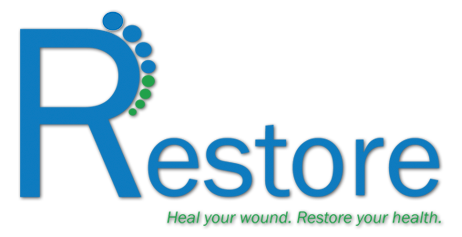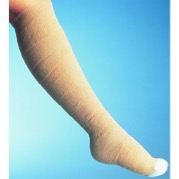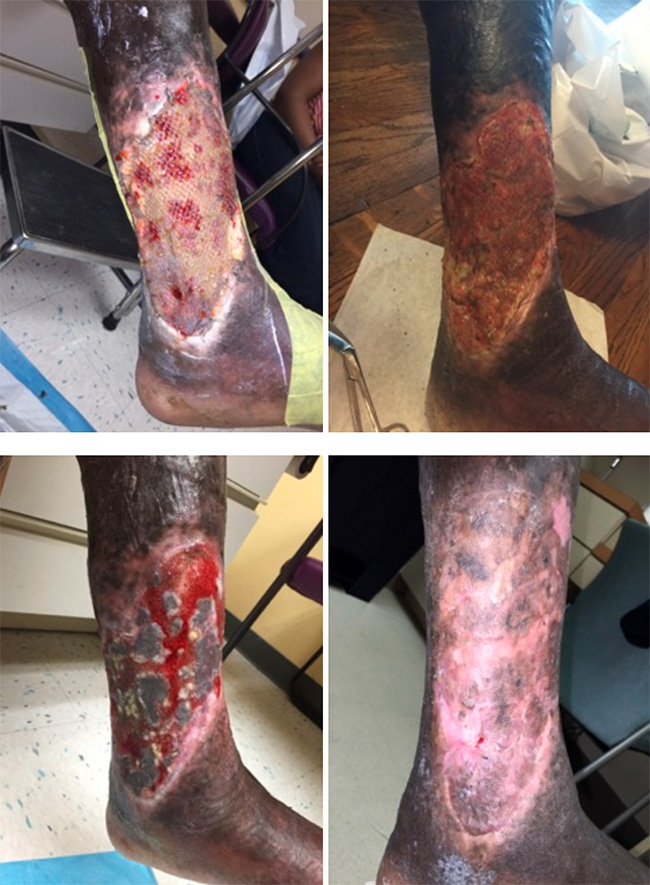Don’t Get Spooked by Treating Your Traumatic Wound


We don’t want to trick you this month, but in honor of Halloween we’ll treat you to some sweet info about the ghastly wounds that have been haunting your days. So don’t get spooked! Just trade your hemoglobin for some hobgoblin and enjoy some levity (or levitation)!

No matter how frightening a traumatic wound can be, go back to the basics:
- Clean the wound thoroughly
- Cover it with a moisture retentive dressing
- Protect it from further harm
See “The ABC’s of Wound Care “ for a good instructional pamphlet on Abrasions, Bruises, Cuts and Skin Tears at the Association for the Advancement of Wound Care (aawconline.org).

 For a venous ulcer, the number one way to treat and heal them is to wrap the leg from the toes to the knee with compression bandages. The method to this madness is to reduce edema in the legs and promote venous return. With legs wrapped, patients are encouraged to walk normally, with a full heel-to-toe gait, NOT like a “Frankenstein” gait, in order to use the calf muscle that will assist venous return. It would be even better to do the Monster Mash!
For a venous ulcer, the number one way to treat and heal them is to wrap the leg from the toes to the knee with compression bandages. The method to this madness is to reduce edema in the legs and promote venous return. With legs wrapped, patients are encouraged to walk normally, with a full heel-to-toe gait, NOT like a “Frankenstein” gait, in order to use the calf muscle that will assist venous return. It would be even better to do the Monster Mash!

 For a venous ulcer, the number one way to treat and heal them is to wrap the leg from the toes to the knee with compression bandages. The method to this madness is to reduce edema in the legs and promote venous return. With legs wrapped, patients are encouraged to walk normally, with a full heel-to-toe gait, NOT like a “Frankenstein” gait, in order to use the calf muscle that will assist venous return. It would be even better to do the Monster Mash!
For a venous ulcer, the number one way to treat and heal them is to wrap the leg from the toes to the knee with compression bandages. The method to this madness is to reduce edema in the legs and promote venous return. With legs wrapped, patients are encouraged to walk normally, with a full heel-to-toe gait, NOT like a “Frankenstein” gait, in order to use the calf muscle that will assist venous return. It would be even better to do the Monster Mash!

Depending on the area of the bite and the type of spider, these spooky arachnoids can make life miserable. There are very few spiders that are dangerous to humans, but the bites can hurt nonetheless. Brown recluse, black widow, and wolf spiders are the more dangerous spiders and medical attention should be sought if bit by one of these scary creatures.
More commonly, even “normal” spiders can cause irritation and itching that may turn into chronic wounds if they bite one who already has compromised healing. For instance, a bite on an ankle with significant venous insufficiency can cause an opening that will not heal easily due to swelling, not necessarily from any venom in the bite. To heal it, the leg may need to be mummified!

Nothing can be more frightening than being unable to heal a chronic wound. When you feel stuck, go back to thinking through all the factors in wound healing:
Is it a local issue:
- A foreign body in the wound somewhere deep down?
- Are the edges so rolled that they cannot advance over the wound surface?
- Is there pressure or friction that is going unchecked?
- Is there a biofilm present that will not permit healing?
Is there some systemic issue:
- A lack of perfusion to the wound bed?
- A lack of nutrition to support healing?
- A medication that may compromise healing?
Be a sleuth and go over a thorough checklist of why the wound will not advance. Once you’ve put The Shining light on them, be sure toexorcise the undesirable factors. Carrie the wound to the finish line!

This blog post was written by Robin Carlson, PT CWS
What is PT CWS? Physical Therapist and Certified Wound Specialist
